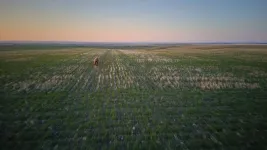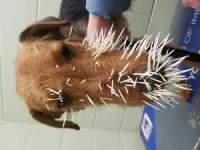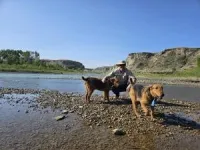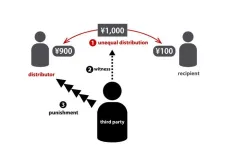(Press-News.org) Brown bears roam across much of the northern hemisphere from the mountains of Spain to the prairies of the US. These bears are formidable carnivores that can weigh up to 751 kg (1,656 lb) and have claws 15 cm (6 in) long. With long canine teeth and a bite force of 6,800,000 pascals (1,000 psi), these bruins can easily crush bones. All these powerful features make brown bears an imposing predator that can take down prey as large and dangerous as an adult bison. Yet, while these bears eat meat, much of their diet is plant-based because they are omnivores. Brown bears have very few dietary restrictions. They are certainly not gluten intolerant because they have been observed laying in big piles of grain, eating wheat by mouthfuls. Nor do they have nut or shellfish allergies. This large dietary breadth, however, causes them to seek out many of the same foods that humans consume. So, just about anywhere you have brown bears and people, you have human-bear conflicts.
In the contiguous US, brown bears, also called grizzly bears, have been a protected species since the 1970s, which has led some populations to increase considerably and expand their range, reclaiming historic habitat. The ecosystems that contain Yellowstone and Glacier National Park have populations of grizzlies that are rebounding so much that bears are moving out from the mountains back onto the prairie, where people and agriculture now dominate the landscape. The return of the grizzly to the Great Plains has been hailed a conservation success story but has come with the unintended consequence of increased human-bear conflicts.
Training bears to stay away
Some people are upset with having to live with such a fearsome animal. Grizzlies can kill livestock, people, and cause property damage. Fortunately, people are not on the typical bear menu and attacks are extraordinarily rare. Nevertheless, their presence makes all these risks possible, and therefore, it is essential for wildlife managers to prevent these conflicts and resolve issues quickly when they do occur. Addressing people’s concerns over grizzly bears is necessary for the successful long-term conservation of the species.
With the expansion of grizzlies onto the prairie, locals demanded more responsiveness to address people’s worries. Montana Fish, Wildlife and Parks and the US Fish and Wildlife Service, the state and federal agencies tasked with managing the protected species, responded by hiring me in 2017. I was the first bear manager based entirely on the Great Plains. Initially, I held a dozen public meetings to hear what people wanted. Resoundingly, people said they didn’t want bears near homes, in town, or damaging property, namely livestock. This seemed like a reasonable request, so I offered to haze bears away. Hazing is the act of the chasing an animal away from an undesirable place or stop it from doing a specific behavior, like attacking livestock. Some people jumped at the idea and offered to help, while others were skeptical. The disbelievers said hazing wouldn’t work or it would merely move a bear to someone else’s land.
With limited information available on hazing, I decided to start collecting data to test if it worked. I wanted to know if hazing was effective at moving bears away from undesirable places. In addition, I wanted to know if it taught grizzlies to stay away from people long-term, which is called aversive conditioning.
From dogs to drones
I started the program with the basic tools of any bear manager - a truck and shotgun with non-lethal deterrents, like cracker shells and rubber rounds. One day, I got a call about a bear in some trees near a family’s house. I drove out to the farm on that rainy day to chase the bear off so the kids and livestock would be safe. My truck, however, was limited by the wet ground - I couldn’t drive up to where the bear was because I would get stuck. So, I went out on foot, shooting the firecracker-like cracker shells from my shotgun. The big, agitated male grizzly didn’t take kindly to my hazing work and charged out at me! Luckily, I was able to stop the large bear with a well-placed cracker in front of him, which spun him around and caused him to flee. After that risky encounter, I decided to get a widely touted, but scientifically untested tool – bear dogs.
A month later I had two adult Airedales, known as the king of terriers, to help me haze grizzlies. I picked this type of dog because the local people favored the breed and conservation outcomes are supposed to be more successful when those local perceptions are considered. It didn’t take long for me to realize that the bear dogs weren’t all they were hyped up to be. Much of the time the two dogs couldn’t detect a bear that I could see across a field, or they chased whatever animal they discovered first. Oftentimes they went after feral cats and porcupines. I tried relentlessly to better train the dogs, but the effort had little effect. Realizing the dogs weren’t a miracle solution, I decided to try a more technological approach that had also never been tested before – drones.
Equipped with a highly maneuverable, buzzing drone I was scattering bears with accuracy. I could precisely chase bears exactly where I wanted them – all from the safety and comfort of my truck. The unmanned aerial vehicle was exactly the magic tool that I had been needing. Even at night, I could find bears from afar with the thermal camera, and then fly in closer to move them away from towns, homes, and livestock. The drone was such an asset that I couldn’t imagine doing the job without it.
Even though all the tools had some success at moving bears away from people, the drone performed notably better than dogs. With the drone I was no longer limited by fences, canals, and other obstacles that would’ve stopped me or limited my range with the other tools. All the hazing work seemed to pay off. Older bears required less hazing, and the number of hazing events declined over each calendar year – evidence that long term aversive conditioning was occurring. Bears appeared to learn to stay away from people. The aversive conditioning likely prevented some conflicts from occurring, which meant bears would be less likely to get into trouble. It was a win-win.
END
Drones could be the ‘magic tools’ we need to chase bears away from people
Guest editorial by Wesley M. Sarmento
2025-01-27
ELSE PRESS RELEASES FROM THIS DATE:
Rethinking altruistic punishment: New experimental insights
2025-01-27
How would you react if someone cut in line behind you? Some people will warn others to follow the rules, even if it does not affect them. This is known as altruistic punishment, the act of punishing others for selfish behavior without reciprocal benefit.
Previous studies on altruistic punishment often placed participants in unnatural settings where they were compelled to observe the selfishness of others and decided whether to punish them. In reality, there are times when avoidance of such a situation takes precedence over confronting unfairness. In other words, a person could pretend they did ...
Move more, age well: Prescribing physical activity for older adults as a recipe for healthy aging
2025-01-27
Can physical activity extend the lifespans of older adults? A review article published in CMAJ (Canadian Medical Association Journal) https://www.cmaj.ca/lookup/doi/10.1503/cmaj.231336 summarizes the considerable evidence supporting the important role physical activity plays in preventing or reducing the effects of diseases and discusses how to prescribe effective exercise for older adults.
Canada’s population is aging, with at least 1 in 5 people aged 65 years or older in 2025, and the number of people older than age 85 years is expected to triple in the next 20 years. However, for many people, ...
Botanic Gardens must team up to save wild plants from extinction
2025-01-27
A major study of botanic gardens around the world has revealed their struggles with one fundamental aim: to safeguard the world’s most threatened plants from extinction.
Researchers analysed a century’s worth of records - from 1921 to 2021 - from fifty botanic gardens and arboreta currently growing half a million plants, to see how the world’s living plant collections have changed over time.
The results suggest that the world’s living collections have collectively reached peak capacity, and that restrictions ...
Approaching the red planet from the kitchen
2025-01-27
Niigata, Japan - Rootless cones are small volcanic landforms ranging from several to several hundred meters in diameter, formed by continuous explosions resulting from the interaction between surface lava and water bodies like lakes and rivers (Figure 1). Unlike regular volcanoes originating from magma rising from deep underground, rootless cones form when lava covers a water-containing layer, triggering explosive reactions. Due to this process, they are also called pseudocraters. While Iceland hosts many rootless cones, they ...
How Camellias evolved with the formation of the Japanese archipelago?
2025-01-27
Niigata, Japan – The distribution of plants has been shaped by geological and climatic changes over time through repeated migration, extinction, and adaptation to new environments. The genus Camellia, comprising over 100 species mainly in East Asia, is a representative warm-temperate tree of the Sino-Japanese Floristic Region.
In Japan, four species of Camellia are found, with Camellia japonica and Camellia rusticana being the most well known. C. japonica has a broad distribution from Aomori Prefecture in the cool-temperate ...
Study succeeds in the early diagnosis of leptomeningeal disease in diffuse midline gliomas by liquid biopsy
2025-01-27
Niigata, Japan – A group led by the Department of Neurosurgery, Brain Research Institute, Niigata University succeeded in the diagnosis of leptomeningeal disease in diffuse midline gliomas by detecting H3K27M-mutant droplets from circulating tumor DNA of cerebrospinal fluid taken from these patients. In two patients, leptomeningeal disease was diagnosed earlier than with traditional methods such as MRI and cerebrospinal fluid cytology. In one patient, long term survival after the diagnosis of leptomeningeal disease by early ...
Understanding the science of meaty flavors could be key to sustainable diets, says academic
2025-01-27
Understanding the science behind meaty tastes and textures could be the key for more people switch to a planet-friendly plant diet, researchers suggest.
Ole G. Mouritsen, a professor of gastrophysics, addresses the urgent need to make changes to culinary cultures where animal-based proteins play a central role.
Replicating a little-known meaty flavour and a sensation of richness could encourage more plant-based eating, he explains.
“To ensure that there is enough food for a growing world population, to lessen the burden on the environment, and to promote healthier, sustainable eating patterns, it ...
Patients who received Ross procedure demonstrate excellent survival rates after 20 years
2025-01-26
LOS ANGELES —January 26, 2024 — Young patients who have undergone the Ross procedure for aortic valve disease have shown excellent long-term survival, the majority without the need for additional surgery two decades later.
These findings, presented today at the 61st annual meeting of The Society of Thoracic Surgeons (STS), were the result of a 22-year study at the Narayana Institute of Cardiac Sciences in Bengaluru, India.
“The Ross operation can be performed safely with results comparable to mechanical valve replacement,” said the study’s lead author, cardiac surgeon ...
Lung volume reduction surgery for emphysema may have better outcomes than previously reported
2025-01-26
LOS ANGELES—January 26, 2025—As contemporary surgical practice continues to evolve, patients who undergo surgical lung volume reduction (LVRS) for advanced emphysema may survive longer and with fewer complications than they did in the past—and they may even fare better than those who opt for endobronchial valve (EBV) placement.
At the 2025 Society of Thoracic Surgeons (STS) Annual Meeting, researchers presented risk-adjusted findings that shed new light on treatments for severe emphysema. Despite having shorter hospital stays, lower hospital ...
New study finds mechanical valves offer superior long-term survival for aortic valve replacement patients aged 60 and younger
2025-01-25
LOS ANGELES—January 25, 2025—A late-breaking study presented today at the 2025 Society of Thoracic Surgeons (STS) Annual Meeting reveals that mechanical aortic valve replacements (AVRs) provide significant long-term survival benefits for patients aged 60 and younger compared to bioprosthetic valves. The study, leveraging data from the STS Adult Cardiac Surgery Database (ACSD), offers the most comprehensive analysis to date of prosthetic valve outcomes, encompassing over 100,000 patients.
The study addressed a critical question ...
LAST 30 PRESS RELEASES:
The Ceramic Society of Japan’s Oxoate Ceramics Research Association launches new international book project
Heart-brain connection: international study reveals the role of the vagus nerve in keeping the heart young
Researchers identify Rb1 as a predictive biomarker for a new therapeutic strategy in some breast cancers
Survey reveals ethical gaps slowing AI adoption in pediatric surgery
Stimulant ADHD medications work differently than thought
AI overestimates how smart people are, according to HSE economists
HSE researchers create genome-wide map of quadruplexes
Scientists boost cell "powerhouses" to burn more calories
Automatic label checking: The missing step in making reliable medical AI
Low daily alcohol intake linked to 50% heightened mouth cancer risk in India
American Meteorological Society announces Rick Spinrad as 2026 President-Elect
Biomass-based carbon capture spotlighted in newly released global climate webinar recording
Illuminating invisible nano pollutants: advanced bioimaging tracks the full journey of emerging nanoscale contaminants in living systems
How does age affect recovery from spinal cord injury?
Novel AI tool offers prognosis for patients with head and neck cancer
Fathers’ microplastic exposure tied to their children’s metabolic problems
Research validates laboratory model for studying high-grade serous ovarian cancer
SIR 2026 delivers transformative breakthroughs in minimally invasive medicine to improve patient care
Stem Cell Reports most downloaded papers of 2025 highlight the breadth and impact of stem cell research
Oxford-led study estimates NHS spends around 3% of its primary and secondary care budget on the health impacts of heat and cold in England
A researcher’s long quest leads to a smart composite breakthrough
Urban wild bees act as “microbial sensors” of city health.
New study finds where you live affects recovery after a hip fracture
Forecasting the impact of fully automated vehicle adoption on US road traffic injuries
Alcohol-related hospitalizations from 2016 to 2022
Semaglutide and hospitalizations in patients with obesity and established cardiovascular disease
Researchers ‘listen in’ to embryo-mother interactions during implantation using a culture system replicating the womb lining
How changing your diet could help save the world
How to make AI truly scalable and reliable for real-time traffic assignment?
Beyond fragmented markets: A new framework for efficient and stable ride-pooling
[Press-News.org] Drones could be the ‘magic tools’ we need to chase bears away from peopleGuest editorial by Wesley M. Sarmento








